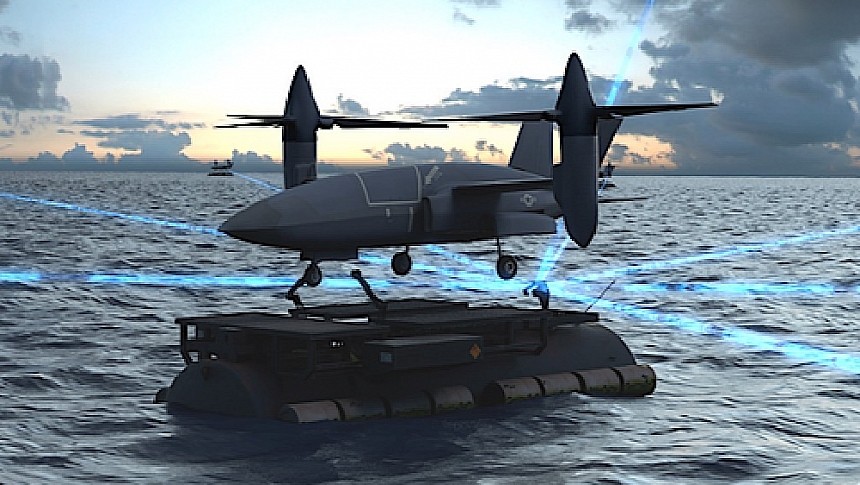American military research agency DARPA has always been at the forefront of technological advancements, and one of its most recent projects, the Speed and Runway Independent Technologies X-plane program, is no exception.
Announced as Phase 1 at the beginning of November, the SPRINT program, as it's also known, aims to come up with "technologies and integrated concepts that can be scaled to different size military aircraft." But not just any kind of aircraft, but the ones that don't really need a prepared surface from which to take off and land.
We know such vehicles, generally, as helicopters, but the military-industrial complex likes to refer to them as vertical lift aircraft. That means a body and a set of propellers that can allow the machine to take off and land in a vertical manner.
The essence of the SPRINT program is the development of an experimental aircraft, but not necessarily to turn that one into a production version. DARPA is looking more at the technologies behind the projects to be submitted by a group of the four companies selected to take part in this project, in a bid to possibly use them elsewhere as well.
The four defense contractors taking part in Phase 1 of the program are Aurora Flight Sciences, Bell Textron, Northrop Grumman, and Piasecki Aircraft Corporation.
All will have to come up with designs that are a combination of aircraft speed and runway independence. For that to happen, prototypes will have to be built. The full requirements are not known, but DARPA did make public a couple of details about the aircraft's speed.
More specifically, the agency is looking for aerial vehicles that can reach jet aircraft-like speeds. Now don't go thinking supersonic, as in this case jet aircraft speeds translate into up to 518 mph (834 kph).
That may not seem like much, but it's dubbed an "unprecedented speed" for such designs. It's also a speed that must be reached and maintained at relevant altitudes.
The vehicles will have to take off like a helicopter and, naturally, will need to have the ability to hover. When on a mission, they will have to have the ability to transition to something that'll allow it to display the capabilities, range, and survivability of jets. What exactly that means is at the moment something between DARPA and the companies taking part in the project.
Of the four companies included in SPRINT only Bell gave us an update, saying it is "currently conducting risk reduction testing at Holloman Air Force Base in New Mexico to demonstrate its folding rotor, integrated propulsion, and flight control technologies using a dedicated test article."
DARPA expects in Phase 1 to see the conceptual design of the aircraft. No timetable was provided as to how fast the project is expected to move.
We know such vehicles, generally, as helicopters, but the military-industrial complex likes to refer to them as vertical lift aircraft. That means a body and a set of propellers that can allow the machine to take off and land in a vertical manner.
The essence of the SPRINT program is the development of an experimental aircraft, but not necessarily to turn that one into a production version. DARPA is looking more at the technologies behind the projects to be submitted by a group of the four companies selected to take part in this project, in a bid to possibly use them elsewhere as well.
The four defense contractors taking part in Phase 1 of the program are Aurora Flight Sciences, Bell Textron, Northrop Grumman, and Piasecki Aircraft Corporation.
All will have to come up with designs that are a combination of aircraft speed and runway independence. For that to happen, prototypes will have to be built. The full requirements are not known, but DARPA did make public a couple of details about the aircraft's speed.
More specifically, the agency is looking for aerial vehicles that can reach jet aircraft-like speeds. Now don't go thinking supersonic, as in this case jet aircraft speeds translate into up to 518 mph (834 kph).
That may not seem like much, but it's dubbed an "unprecedented speed" for such designs. It's also a speed that must be reached and maintained at relevant altitudes.
The vehicles will have to take off like a helicopter and, naturally, will need to have the ability to hover. When on a mission, they will have to have the ability to transition to something that'll allow it to display the capabilities, range, and survivability of jets. What exactly that means is at the moment something between DARPA and the companies taking part in the project.
Of the four companies included in SPRINT only Bell gave us an update, saying it is "currently conducting risk reduction testing at Holloman Air Force Base in New Mexico to demonstrate its folding rotor, integrated propulsion, and flight control technologies using a dedicated test article."
DARPA expects in Phase 1 to see the conceptual design of the aircraft. No timetable was provided as to how fast the project is expected to move.








